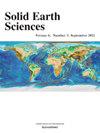Early Permian magmatism above a slab window in Inner Mongolia, North China: Implications for the Paleo-Asian Ocean subduction processes and accretionary crustal growth
Abstract
Identifying magmatic rock associations in a subduction zone is substantial for understanding the related geodynamic evolution. The final closure time of the Paleo-Asian Ocean and the exact subduction processes have continuously been controversial, hindering our recognition of the tectonic evolution of the Central Asian Orogenic Belt (CAOB). Here we investigated the Early Permian gabbros-granodiorites from Xi Ujimqin in the northern Inner Mongolian region. The gabbros have slightly depleted light rare-earth elements [(La/Yb)N = 0.8] and flat heavy rare earth elements (HREE) [(Gd/Yb)N = 1.1] that are comparable to those of N-MORB. They show depletion in Nb and Ta, positive whole-rock εNd(t) values of +7.7 to +8.7 and zircon εHf(t) values of +8.7 to +10.6. These mafic rocks are interpreted to be products of partial melting of depleted mantle that had been metasomatized by slab-derived fluids, with subsequent fractional crystallization and minor crustal contamination. These granodiorites chemically resemble typical adakites and have MORB-like whole-rock SrNd isotopic compositions (87Sr/86Sri = 0.7028–0.7029; εNd(t) = +8.2–+8.5) and positive zircon εHf(t) (+13.4–+15.9) values, suggesting that they originated from the subducted slab-melts and reacted with mantle wedge peridotite. U
Pb zircon dating shows emplacement of N-MORB-type gabbros and adakitic granodiorites at ∼297 Ma and ∼290 Ma, respectively. Our new data indicate the presence coeval slab-derived adakites and slab fluid-metasomatized asthenosphere-derived N-MORB-type rocks, indicating that subduction lasted until at least the Early Permian. Such an association along with the extension-related magmatism in northern Mongolia recorded the northward ridge subduction of the Paleo-Asian Ocean during the Late Carboniferous–Early Permian. This model is consistent with the spatial distribution and the ages of magmatic activity with positive εNd(t)–εHf(t) values from this region. Ridge subduction and induced slab windows probably played a key role in Paleozoic crustal growth of CAOB, and by inference in the other accretionary orogens throughout Earth history.

 求助内容:
求助内容: 应助结果提醒方式:
应助结果提醒方式:


